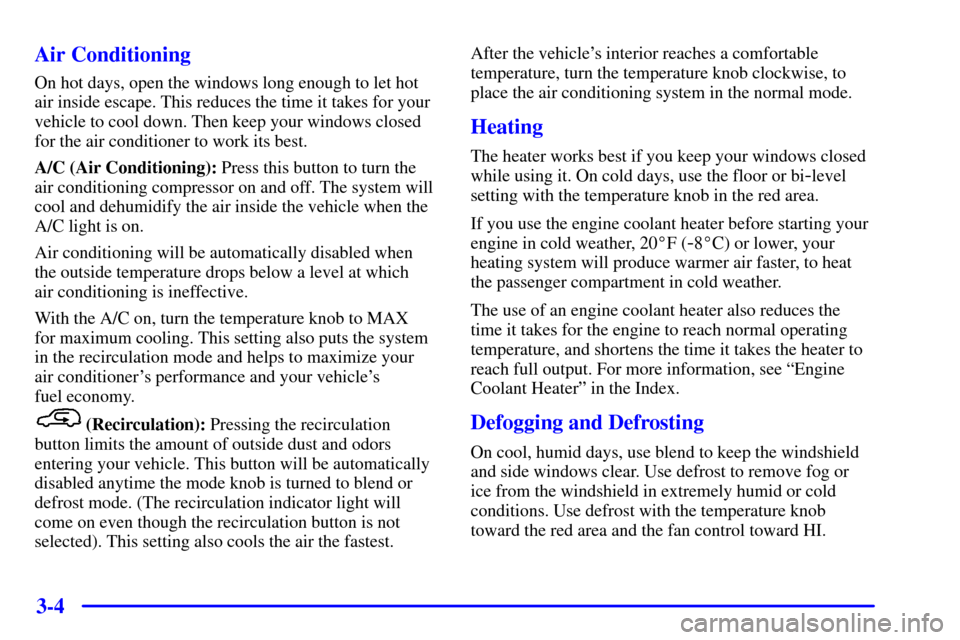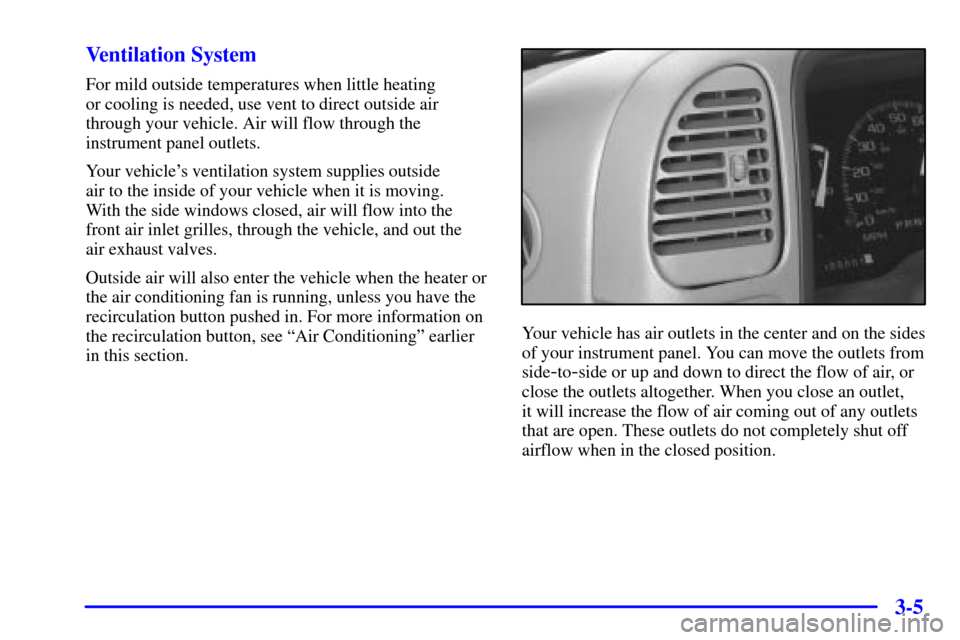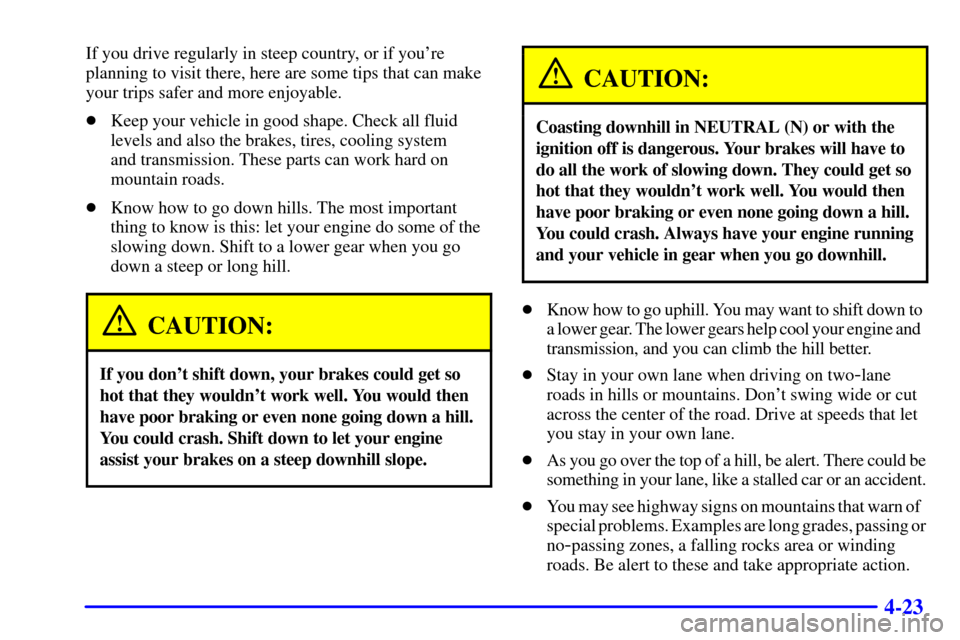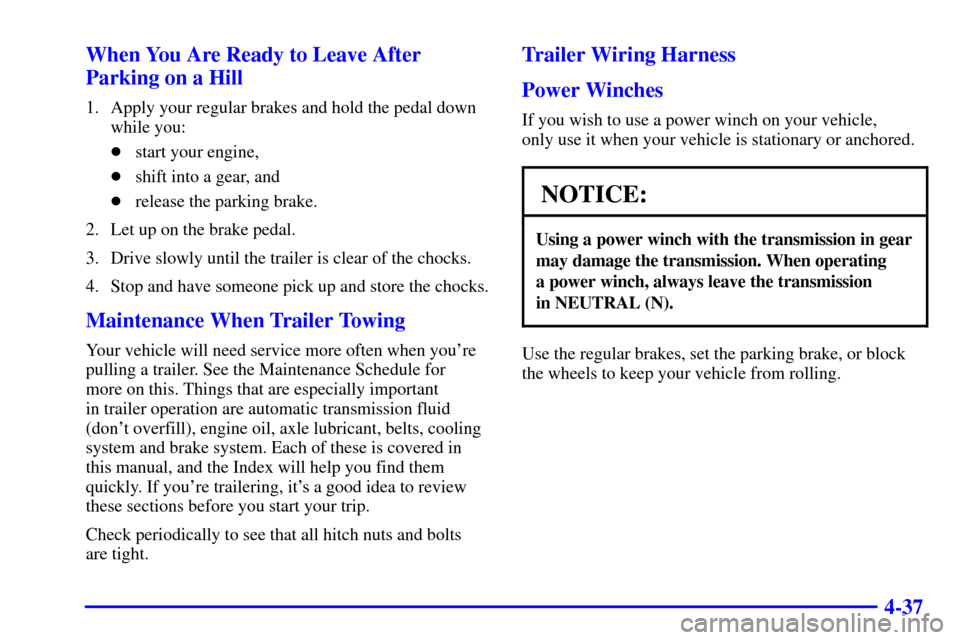Page 99 of 331
2-56 Engine Coolant Temperature Gage
This gage shows the engine
coolant temperature.
It also provides an indicator of how hard your vehicle is
working. During a majority of the operation, the gage
will read 210�F (100�C) or less. If you are pulling a
load or going up hills, it is normal for the temperature to
fluctuate and approach the 260�F (125�C) mark. If the
gage reaches the 260�F (125�C) mark, it indicates that
the cooling system is working beyond its capacity.
See ªEngine Overheatingº in the Index.
Malfunction Indicator Lamp (Service
Engine Soon Light in the United States
or Check Engine Light in Canada)
(Gasoline Engine)
United States Canada
Your vehicle is equipped with a computer which
monitors operation of the fuel, ignition and emission
control systems.
Page 103 of 331
2-60 Reduced Engine Power
The REDUCED ENGINE
POWER light will come
on when the cooling system
temperature gets too hot
and the engine further
enters the engine coolant
protection mode.
See ªEngine Overheatingº in the Index for
further information.
Oil Pressure Gage
United States Canada
The oil pressure gage shows the engine oil pressure in
psi (pounds per square inch) when the engine is running.
Canadian vehicles indicate pressure in kPa (kilopascals).
Page 110 of 331

3-4 Air Conditioning
On hot days, open the windows long enough to let hot
air inside escape. This reduces the time it takes for your
vehicle to cool down. Then keep your windows closed
for the air conditioner to work its best.
A/C (Air Conditioning): Press this button to turn the
air conditioning compressor on and off. The system will
cool and dehumidify the air inside the vehicle when the
A/C light is on.
Air conditioning will be automatically disabled when
the outside temperature drops below a level at which
air conditioning is ineffective.
With the A/C on, turn the temperature knob to MAX
for maximum cooling. This setting also puts the system
in the recirculation mode and helps to maximize your
air conditioner's performance and your vehicle's
fuel economy.
(Recirculation): Pressing the recirculation
button limits the amount of outside dust and odors
entering your vehicle. This button will be automatically
disabled anytime the mode knob is turned to blend or
defrost mode. (The recirculation indicator light will
come on even though the recirculation button is not
selected). This setting also cools the air the fastest.After the vehicle's interior reaches a comfortable
temperature, turn the temperature knob clockwise, to
place the air conditioning system in the normal mode.
Heating
The heater works best if you keep your windows closed
while using it. On cold days, use the floor or bi
-level
setting with the temperature knob in the red area.
If you use the engine coolant heater before starting your
engine in cold weather, 20�F (
-8�C) or lower, your
heating system will produce warmer air faster, to heat
the passenger compartment in cold weather.
The use of an engine coolant heater also reduces the
time it takes for the engine to reach normal operating
temperature, and shortens the time it takes the heater to
reach full output. For more information, see ªEngine
Coolant Heaterº in the Index.
Defogging and Defrosting
On cool, humid days, use blend to keep the windshield
and side windows clear. Use defrost to remove fog or
ice from the windshield in extremely humid or cold
conditions. Use defrost with the temperature knob
toward the red area and the fan control toward HI.
Page 111 of 331

3-5 Ventilation System
For mild outside temperatures when little heating
or cooling is needed, use vent to direct outside air
through your vehicle. Air will flow through the
instrument panel outlets.
Your vehicle's ventilation system supplies outside
air to the inside of your vehicle when it is moving.
With the side windows closed, air will flow into the
front air inlet grilles, through the vehicle, and out the
air exhaust valves.
Outside air will also enter the vehicle when the heater or
the air conditioning fan is running, unless you have the
recirculation button pushed in. For more information on
the recirculation button, see ªAir Conditioningº earlier
in this section.
Your vehicle has air outlets in the center and on the sides
of your instrument panel. You can move the outlets from
side
-to-side or up and down to direct the flow of air, or
close the outlets altogether. When you close an outlet,
it will increase the flow of air coming out of any outlets
that are open. These outlets do not completely shut off
airflow when in the closed position.
Page 155 of 331

4-23
If you drive regularly in steep country, or if you're
planning to visit there, here are some tips that can make
your trips safer and more enjoyable.
�Keep your vehicle in good shape. Check all fluid
levels and also the brakes, tires, cooling system
and transmission. These parts can work hard on
mountain roads.
�Know how to go down hills. The most important
thing to know is this: let your engine do some of the
slowing down. Shift to a lower gear when you go
down a steep or long hill.
CAUTION:
If you don't shift down, your brakes could get so
hot that they wouldn't work well. You would then
have poor braking or even none going down a hill.
You could crash. Shift down to let your engine
assist your brakes on a steep downhill slope.
CAUTION:
Coasting downhill in NEUTRAL (N) or with the
ignition off is dangerous. Your brakes will have to
do all the work of slowing down. They could get so
hot that they wouldn't work well. You would then
have poor braking or even none going down a hill.
You could crash. Always have your engine running
and your vehicle in gear when you go downhill.
�Know how to go uphill. You may want to shift down to
a lower gear. The lower gears help cool your engine and
transmission, and you can climb the hill better.
�Stay in your own lane when driving on two
-lane
roads in hills or mountains. Don't swing wide or cut
across the center of the road. Drive at speeds that let
you stay in your own lane.
�As you go over the top of a hill, be alert. There could be
something in your lane, like a stalled car or an accident.
�You may see highway signs on mountains that warn of
special problems. Examples are long grades, passing or
no
-passing zones, a falling rocks area or winding
roads. Be alert to these and take appropriate action.
Page 169 of 331

4-37 When You Are Ready to Leave After
Parking on a Hill
1. Apply your regular brakes and hold the pedal down
while you:
�start your engine,
�shift into a gear, and
�release the parking brake.
2. Let up on the brake pedal.
3. Drive slowly until the trailer is clear of the chocks.
4. Stop and have someone pick up and store the chocks.
Maintenance When Trailer Towing
Your vehicle will need service more often when you're
pulling a trailer. See the Maintenance Schedule for
more on this. Things that are especially important
in trailer operation are automatic transmission fluid
(don't overfill), engine oil, axle lubricant, belts, cooling
system and brake system. Each of these is covered in
this manual, and the Index will help you find them
quickly. If you're trailering, it's a good idea to review
these sections before you start your trip.
Check periodically to see that all hitch nuts and bolts
are tight.
Trailer Wiring Harness
Power Winches
If you wish to use a power winch on your vehicle,
only use it when your vehicle is stationary or anchored.
NOTICE:
Using a power winch with the transmission in gear
may damage the transmission. When operating
a power winch, always leave the transmission
in NEUTRAL (N).
Use the regular brakes, set the parking brake, or block
the wheels to keep your vehicle from rolling.
Page 173 of 331
5-
5-1
Section 5 Problems on the Road
Here you'll find what to do about some problems that can occur on the road.
5
-2 Hazard Warning Flashers
5
-2 Other Warning Devices
5
-3 Jump Starting
5
-9 Towing Your Vehicle
5
-9 Engine Overheating (Gasoline Engine)5
-13 Cooling System (Gasoline Engine)
5
-21 Engine Fan Noise
5
-21 If a Tire Goes Flat
5
-22 Changing a Flat Tire
5
-23 If You're Stuck: In Sand, Mud, Ice or Snow
Page 185 of 331
5-13
Cooling System (Gasoline Engine)
When you decide it's safe to lift the hood, here's what
you'll see:
A. Coolant Recovery Tank
B. Radiator Pressure Cap
C. Engine Cooling Fan(s)
CAUTION:
If your vehicle has air conditioning, the auxiliary
electric engine cooling fan under the hood can
start up even when the engine is not running and
can injure you. Keep hands, clothing and tools
away from any underhood electric fan.
If the coolant inside the coolant recovery tank is boiling,
don't do anything else until it cools down. The vehicle
should be parked on a level surface.
The coolant level
should be at or above
the COLD mark. If it
isn't, you may have a
leak at the pressure cap
or in the radiator
hoses, heater hoses,
radiator, water pump
or somewhere else in
the cooling system.